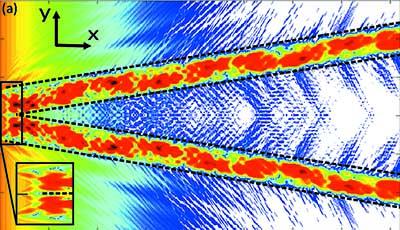X-ray optics on a chip

Dashed lines mark the channel boundaries and the enlarged part displays the region where the wave is coupled in. The intensity is normalized and plotted in logarithmic scaling. Credit: Hoffmann-Urlaub and Salditt
In the latest issue of Acta Crystallographica Section A: Foundations and Advances , Sarah Hoffmann-Urlaub and Tim Salditt report the fabrication and testing of a millimetre-sized chip capable of splitting a beam of X-rays [Acta Cryst. (2016), A72, doi:10.1107/S205327331601144X].
Fork-shaped channels that are only a few tens of nanometres wide and deep are transferred into a silicon wafer using electron-beam lithography and reactive ion etching then enclosed by bonding a second silicon wafer on top.
The results of simulations of how the 'parent' beam is split into two 'daughter' beams on passing through the chip were backed up by experimental measurements at the European Synchrotron Radiation Facility, showing that the incident beam is efficiently transported through the chip, neatly split and guided to exits that have precisely controlled (and tunable) spacings.
After the daughter beams leave the chip, they interfere, leading to a pattern of vertical stripes just like the pattern obtained from a classical Young's double-slit interference experiment. Interestingly, on close inspection there are fork-like structures within the stripes that originate from discontinuities in the phase of the recombined beam, forming striking features known as phase vortices.
Furthermore, from those interference patterns the intensity distribution in the exit plane of the channels is reconstructed, which is found to be in very good agreement to the actual channel design.
This study complements earlier work on two-dimensionally confined channels in silicon in straight and tapered geometries, and paves the way to realizing `X-ray optics on a chip'. Illumination of samples by the two beams could provide some interesting advantages for coherent imaging and opens up the possibility of a new form of nano-interferometer.
The authors envisage future development of their beamsplitter to create several daughter beams from the same parent beam, which would allow a single object to be imaged simultaneously by several beams, each from a different direction.
Media Contact
All latest news from the category: Physics and Astronomy
This area deals with the fundamental laws and building blocks of nature and how they interact, the properties and the behavior of matter, and research into space and time and their structures.
innovations-report provides in-depth reports and articles on subjects such as astrophysics, laser technologies, nuclear, quantum, particle and solid-state physics, nanotechnologies, planetary research and findings (Mars, Venus) and developments related to the Hubble Telescope.
Newest articles

Bringing bio-inspired robots to life
Nebraska researcher Eric Markvicka gets NSF CAREER Award to pursue manufacture of novel materials for soft robotics and stretchable electronics. Engineers are increasingly eager to develop robots that mimic the…

Bella moths use poison to attract mates
Scientists are closer to finding out how. Pyrrolizidine alkaloids are as bitter and toxic as they are hard to pronounce. They’re produced by several different types of plants and are…

AI tool creates ‘synthetic’ images of cells
…for enhanced microscopy analysis. Observing individual cells through microscopes can reveal a range of important cell biological phenomena that frequently play a role in human diseases, but the process of…





















